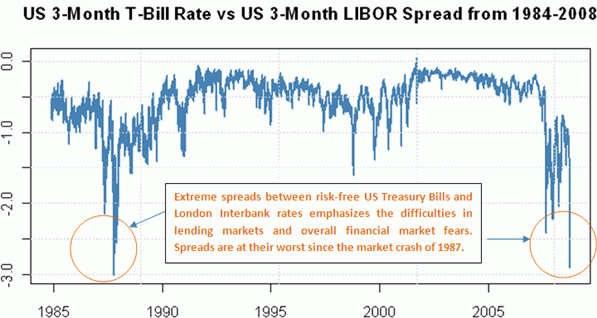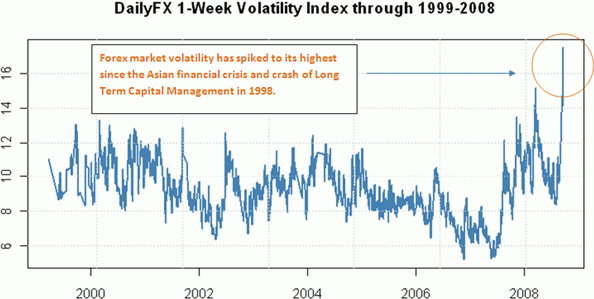| US Treasury Bill Rates Drop to Lowest Since 1954 |
| By David Rodriguez |
Published
09/17/2008
|
Currency , Futures , Options , Stocks
|
Unrated
|
|
|
|
US Treasury Bill Rates Drop to Lowest Since 1954
Today, the 3-month US Treasury Bill yield fell to the lowest since 1954. Dramatic declines in US T-Bill yields underline the level of risk aversion in global financial markets, as traders around the world move their funds into risk-free US government debt. Such dynamics should continue to support lower-yielding currencies such as the Japanese Yen, which likewise appreciates during times of financial market risk aversion.
The overall level of market risk aversion can clearly be seen in the difference between the T-Bill rate and the equivalent money market yield. Indeed, the chart below shows that the Treasury-LIBOR spread now stands at its highest levels since the US stock market crash of October, 1987. Intense global fears on the state of financial markets have likewise had a clear effect on liquidity available across global dealing desks, as major financial institutions become unwilling to lend money and significantly scale back position risk across various assets.

Financial market disruptions thus translate into nearly-unprecedented volatility across key asset classes, and forex markets have seen historic volatility as of late. Indeed, our DailyFX 1-week volatility index is now at its highest since the inception of the euro—underlining financial market duress and fears that extreme price moves may continue through the coming days.

Such extreme money market illiquidity only exacerbates market volatility, and the ongoing flight to quality makes market-makers in all markets unwilling to take risks. The net effect for traders is that bid/ask spreads across all traded instruments have widened considerably, and available liquidity at any price is significantly worse than in normal market conditions. Traders should be careful not to take undue risk in forex trading, as it has become increasingly clear that liquidity is scarce and they may be subject to poor price fills until conditions show substantial improvement.
David Rodriguez is a Currency Analyst at FXCM.
|